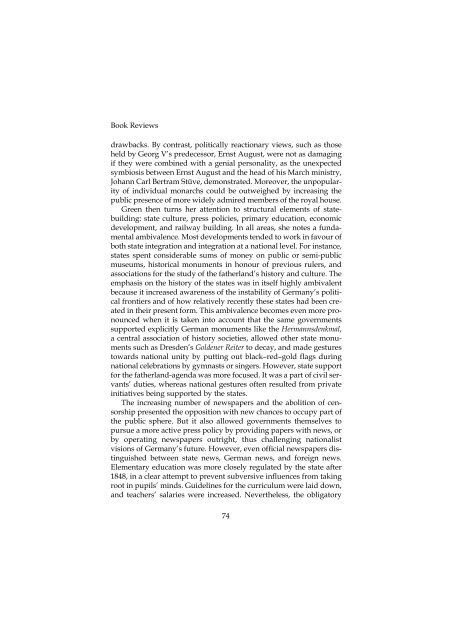Download - German Historical Institute London
Download - German Historical Institute London
Download - German Historical Institute London
You also want an ePaper? Increase the reach of your titles
YUMPU automatically turns print PDFs into web optimized ePapers that Google loves.
Book Reviews<br />
drawbacks. By contrast, politically reactionary views, such as those<br />
held by Georg V’s predecessor, Ernst August, were not as damaging<br />
if they were combined with a genial personality, as the unexpected<br />
symbiosis between Ernst August and the head of his March ministry,<br />
Johann Carl Bertram Stüve, demonstrated. Moreover, the unpopularity<br />
of individual monarchs could be outweighed by increasing the<br />
public presence of more widely admired members of the royal house.<br />
Green then turns her attention to structural elements of statebuilding:<br />
state culture, press policies, primary education, economic<br />
development, and railway building. In all areas, she notes a fundamental<br />
ambivalence. Most developments tended to work in favour of<br />
both state integration and integration at a national level. �or instance,<br />
states spent considerable sums of money on public or semi-public<br />
museums, historical monuments in honour of previous rulers, and<br />
associations for the study of the fatherland’s history and culture. The<br />
emphasis on the history of the states was in itself highly ambivalent<br />
because it increased awareness of the instability of <strong>German</strong>y’s political<br />
frontiers and of how relatively recently these states had been created<br />
in their present form. This ambivalence becomes even more pronounced<br />
when it is taken into account that the same governments<br />
supported explicitly <strong>German</strong> monuments like the Hermannsdenkmal,<br />
a central association of history societies, allowed other state monuments<br />
such as Dresden’s Goldener Reiter to decay, and made gestures<br />
towards national unity by putting out black–red–gold flags during<br />
national celebrations by gymnasts or singers. However, state support<br />
for the fatherland-agenda was more focused. It was a part of civil servants’<br />
duties, whereas national gestures often resulted from private<br />
initiatives being supported by the states.<br />
The increasing number of newspapers and the abolition of censorship<br />
presented the opposition with new chances to occupy part of<br />
the public sphere. But it also allowed governments themselves to<br />
pursue a more active press policy by providing papers with news, or<br />
by operating newspapers outright, thus challenging nationalist<br />
visions of <strong>German</strong>y’s future. However, even official newspapers distinguished<br />
between state news, <strong>German</strong> news, and foreign news.<br />
Elementary education was more closely regulated by the state after<br />
1848, in a clear attempt to prevent subversive influences from taking<br />
root in pupils’ minds. Guidelines for the curriculum were laid down,<br />
and teachers’ salaries were increased. Nevertheless, the obligatory<br />
74













